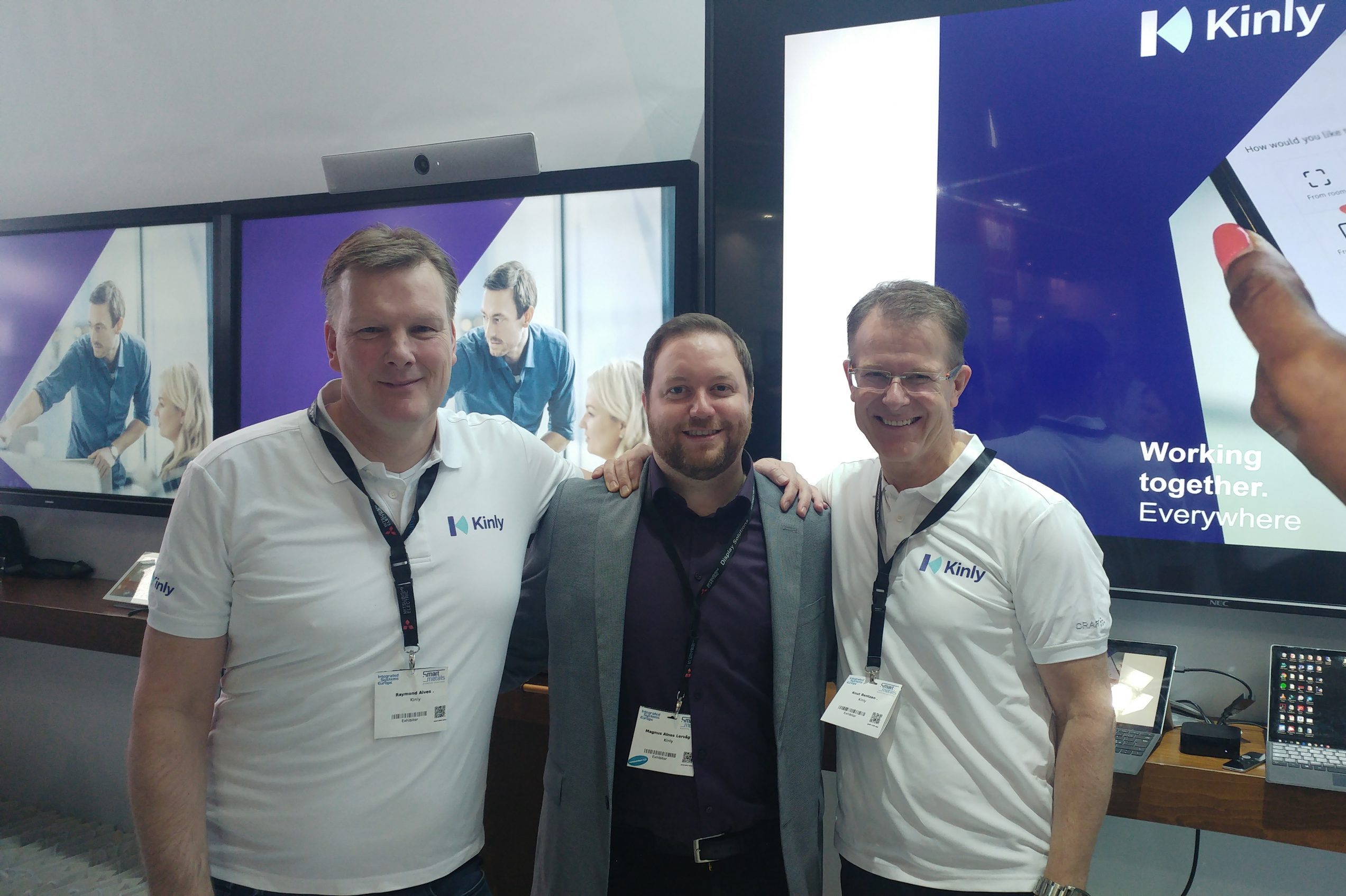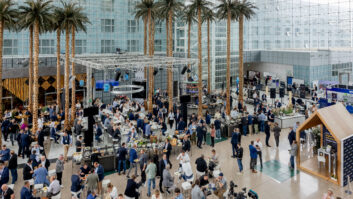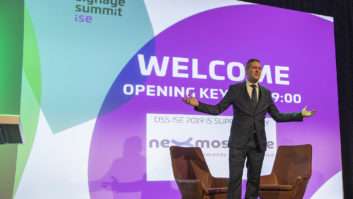
A new name in collaboration was born at ISE 2018 – Kinly, formed from the merger of VisionsConnected and Viju. On the last morning of the the show, Paddy Baker spoke to three Kinly executives to find out about the new company’s approach to the market – and why “technology is not the thing anymore.”
ISE 2018 saw the launch of one of the world’s largest systems integration companies: Kinly – formed from the merger of VisionsConnected and Viju. This follows the acquisition of both companies by an investor last September.
The combined company has a formidable global presence, as chief marketing officer Knut Bentzen explains: “We have offices in Scandinavia, and now the legal head office in Amsterdam, we are across the UK, we are on the east coast of the US – and will grow further in the US – and we’ve got offices in Singapore and Kuala Lumpur. Our own operational head office is not even a physical one, but a global CloudRoom. We have done projects in more than 120 countries across the world. We understand the nature of global business: we are used to dealing with challenges like Brazil, where there are 13 different states and customs between every one of them.”
Viju and VisionsConnected were both leading players in video communications, and so it’s not surprising that Kinly – whose company slogan is ‘Working together. Everywhere’ – is entirely devoted to collaboration projects.
We have several examples of solutions that don’t look like a standard meeting room, but are optimised for a specific purpose
Chief solutions officer Raymond Alves – previously CEO of VisionsConnected – observes that, over the past 10 years, customer demands have changed. “There is a lot of collaboration within an organisation and between organisations and that collaboration does not always work in a perfect manner. So we have been dealing with a lot of technological fixes to make meetings run. And while doing that, we worked with a lot of partners – but at the end the customer was asking, ‘Can you take overall responsibility for all those meetings? I want to have one contact and one contract. What can you do?’ Now it’s getting interesting.
“We found an investor and started to believe that this thing could work – meaning taking over all responsibility of meetings. Then basically we picked up the phone to Viju and said, we have something new, how about joining this party together? And if we do that, we need to elaborate on a new story – because technology is not the thing any more, the thing is how we make meetings run in an effective way.”
According to Alves, there is a large opportunity for Kinly because of the fragmented nature of the integration market, particularly when it comes to serving multinational companies.
“Take a global organisation in the fast-moving consumer world. They might have 40 to 50 different AV contractors across the globe. We’re talking about how teams should work efficiently together within the organisation and between their customers and partners. If all those different AV contractors make their own technology decisions about how it should work together – it’s a mess.
“There is a long way to go, but if we have these international capabilities and the ambition to standardise in such a way that the technology works smoothly together, then we’re giving ourselves a good chance that we can win those contracts on a global level in the next contracting round. So let’s have this conversation next year, and I promise you, we will have some new announcements to make.”
Understanding users
One of the refreshing things talking to the Kinly team is that they clearly understand that not all meetings are the same, and not all collaboration is the same. So rather than looking to impose a one-size-fits-all solution, they seek to understand the users and their work before talking about technology.
Bentzen talks about an ‘activity-based workspace’: “It’s not a standard meeting room where you go in and fit your work process into the room. It’s kind of the opposite: different spaces and places that are optimised for a type of activity. We have several examples of solutions that don’t look like a standard meeting room, but are optimised for a specific purpose.”
Collaboration consultant Magnus Lervåg explains: “It’s not only the technologies, how the room is built, furniture, chairs and everything. What are the stand-up activities, what are the sit-down activities? Is it something you want to do for a long time or a short period? Is it something that needs high focus? Should you be with people or alone? It’s stuff like that, so you can choose your own workplace based on your activity. It makes people think about what their task is and where to do it. To be able to create these spaces for people to work more efficiently, it’s really something.”
Bentzen continues: “We have had such a wonderful response about this because I think a lot of people recognise themselves in the troubles of navigating this jungle of technology… People are working all different places these days, but they still physically need to be somewhere. That’s a physical workspace. And then you have the digital workspace with its endless possibilities. Our core goal is to make these two worlds – the physical and the digital – come together as one and create that seamless experience where you can work naturally.
“One of the things that Magnus is working on is helping customers to standardise and make this a consistent experience across the board.”
A key point is that users should find the experience simple and intuitive: Lervåg comments: “It should be easy, they should not be aware that it’s technology or equipment or hardware that’s doing this, it should feel natural. We work a lot on that.”
Using own technologies
With multiple locations across the globe, Kinly is in a good position to use its own technologies – and thus work to improve the user experience.
Bentzen mentions the old saying about the shoemaker’s children always being barefoot: “Well, in this family, the children are walking around in proper hiking boots. And that means that we also find things out – whoops, that one gives me a blister when I walk on steep hills, so I need to change something – because we experience these problems ourselves.”
I think the keyboard will quite soon be something that we do not use anymore
So what are the tools and technologies that Kinly uses to create these tailored collaboration spaces? Bentzen comments: “It’s very tempting to start talking about some of the technologies that apply; and of course in many cases there is a camera involved because customers want videoconferencing. But we also do a lot that does not involve videoconferencing at all, it is about enhancing collaboration in that specific room… To answer your question, I have an almost infinite toolbox of technology. Probably the most important tool that Magnus and his colleagues in the sales team and design teams use is our methodology to reveal what work process are you going to support? Which roles are involved in that work process? Where do they sit? How do they act, and what is the workflow?
“We’re not McKinsey, but Kinly is focused on a data-driven approach because if we aren’t relevant to the line of business and the CFO, well, the user can like us as much as they want but they’re not going to be paying for our solutions.”
He describes a recently launched initiative called Customer Success Services: “It’s about training and helping people in both using their plain solutions and also doing more scenario-based training for the more advanced solutions. We’re moving away from a situation where we installed, and if it was an on-time on-budget install, and support was secured, then fine, thank you, our journey has ended, find the next customer. That is now starting to become the point in time where our journey starts, as we are in it every step of the way together with the client to make them succeed.”
Importance of touch
Alongside the internet (and the cloud), Bentzen believes that the most significant development of the past quart-century or so was “what Steve Jobs did when he taught us that we can touch our computer with our finger. So instead of using a keyboard – and I think the keyboard will quite soon be something that we do not use any more, it will be an anomaly in history that we used for a period of time – we will be using touch, voice recognition and other ways of entering and interacting with information into our data systems.”
This feeds into an important part of Kinly’s design philosophy, and according to Bentzen, “the single tool we think will really make a difference.”
He elaborates: “There’s no single piece of technology any modern person has spent more time learning to use than their phone. They’re just not aware of it, because they have it in their pocket and they use it constantly. That principle we’ve taken to the meeting room. The touchpanels that you will find in our meeting rooms are just like a phone; the computers we put our interfaces on act like a phone, and we have developed an app that will help you use these solutions.”
Thomas Edberg, senior director, cloud collaboration business development, gives me a quick demonstration of the app on his phone. Everything is controlled from a few cleanly designed screens: receiving a meeting invitation, accepting the invitation or requesting it be rescheduled; joining the meeting from a room (in which case the app will suggest nearby rooms, or rooms the user has used before); joining from a PC, in which case the app will use the appropriate communications platform if it is installed, or send a webRTC link if not; or joining from a mobile phone. It’s even possible to join from a physical room in a building that the user is visiting; and there is also an ‘audio only’ option for people who just want to listen in – maybe they have been caught up in traffic on their way to the meeting.
There is also functionality for managing meetings, such as muting and unmuting participants, and inviting additional people to come into a meeting on an ad-hoc basis.
There’s a great sense of optimism and confidence coming from my interviewees, along with broad smiles that one doesn’t often see on the last morning of a major trade show. I look forward to seeing Alves’ prediction of major contract wins coming true.
Pictured L-R: Raymond Alves, Magnus Lervåg, Knut Bentzen







